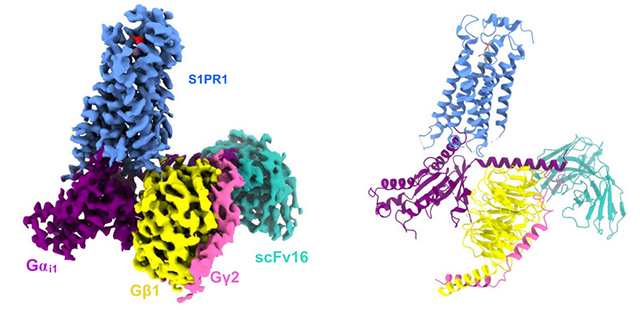HIT All Media (Yuanzheng He Text/Picture) On December 23, Yuanzheng He’s research team from the HIT Center for Life Sciences published their research findings in Nature Chemical Biology, entitled Structural basis of sphingosine-1-phosphate receptor 1 activation and biased agonism. The research reported the cryo-electron microscopy (cryo-EM) structures of Gi-bound S1PR1 to reveal the structural basis of the S1PR1 biased signal path caused by endogenous ligand and drug modulators.
S1P, a metabolite of membrane sphingolipids, regulates inflammatory response, cell migration, angiogenesis, and neuronal and cardiac development. Dysregulations of S1P signaling are associated with autoimmune, cardiovascular, and neurodegenerative diseases and cancers. S1P exerts its physiological functions predominantly by binding to S1PRs (S1PR1-S1PR5). Because the S1P-S1PR1 signal plays a critical role in the egress of lymphocytes from the lymphoid organs, S1PR1 is an important drug target for the treatment of multiple sclerosis (MS). Mechanistically, different from the endogenous ligand S1P, the drug modulators fingolimod (FTY720) and siponimod (BAF312) activate the receptor and associate with β-arrestin biased signaling path. It causes persistent internalization of S1PR1 in lymphocytes, which prevents egress of autoreactive lymphocytes from lymphoid organs, resulting in attenuation of inflammatory responses on the nervous system. However, the conformational differences of S1PR1 biased activation caused by drug modulators remain elusive.
Yuanzheng He’s team first analyzed the structures of three complexes of Gi-bound S1PR1 in complex with endogenous ligand S1P, drug modulators FTY720-P, and BAF312 through cryo-electron microscopy. Structural analysis and functional data indicate that the three ligands bind to the receptor by different mechanisms, in which S1P and FTY720-P are similar. Their polar or charged residues are positioned above the binding pocket, and the hydrophobic tail is positioned below the hydrophobic binding pocket. BAF312 binds to receptors mainly through extensive hydrophobic interaction. Compared with the inactive structure of S1PR1, the outward displacement of transmembrane 6 (TM6) occurred in all bound S1PR1 structures with the three ligands, indicating the conformational changes after receptor activation, resulting in the formation of Gαi engaging site. The structural comparison of antagonistic and activated states indicates that the most notable difference is the position and the orientation of W2696.48 in the ligand binding pocket. In the antagonist-bound pocket, the indole ring W2696.48 is perpendicular to the membrane plane. In the agonist S1P-bound pocket, the indole ring flips W2696.48 about 70° toward TM5. But the side chains of W2696.48 in the receptor structure FTY720-P- and BAF312-bound pockets are intermediate between S1P and antagonist, suggesting that orientation of W2696.48 indole ring may behave as a sensor for β-arrestin ligand property. In combination with functional assays and molecular dynamics (MD) studies, the research reveals that β-arrestin biased ligand changes the ligand recognition mode of S1PR1 through its different structure. It causes extensive interplay between receptor PIF and NPxxY motif and activates different signal paths downstream of S1PR1. The intermediate flipping of W2696.48 and the retained interaction between F2656.44 and N3077.49 are the key features of the β-arrestin bias. In addition, the study found L2766.55 and L2977.39 are the key sites for S1PR1 to specific response to BAF312 of S1PR1. This research provides a theoretical basis for a new approach of β-arrestin biased drugs with efficacy and safety and subtype-selective receptor drugs.
HIT Center for Life Sciences and Tohoku University in Japan collaborated on this project. Doctoral students Zhenmei Xu in Yuanzheng He team and Tatsuya Ikuta in the Graduate School of Pharmaceutical Sciences, Tohoku University were co-first authors. Doctoral students Yu Qian and Ruixue Xia in Yuanzheng He team contributed to the research. Senior Engineer Changyou Guo and Engineer Anqi Zhang in the HIT cry-EM facility collected data with the team. Research scientist Yuanzheng He and Professor Asuka Inoue in the Graduate School of Pharmaceutical Sciences, Tohoku University were co-corresponding authors of the manuscript.
Link to the original text: https://www.nature.com/articles/s41589-021-00930-3

Fig. 1 Cryo-electron microscopy (cryo-EM) structures of Gi-bound S1PR1

Fig. 2 The structure of S1PR1 reveals the molecular mechanism of current drugs for the treatment of multiple sclerosis


